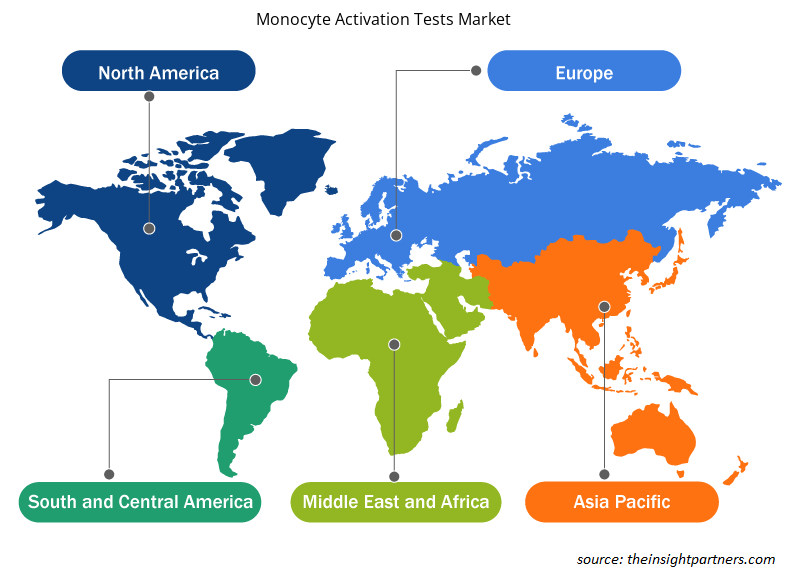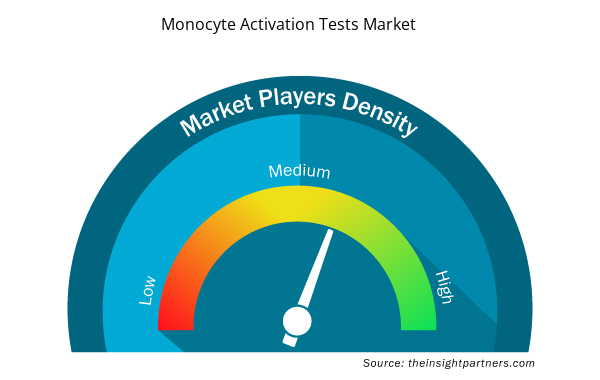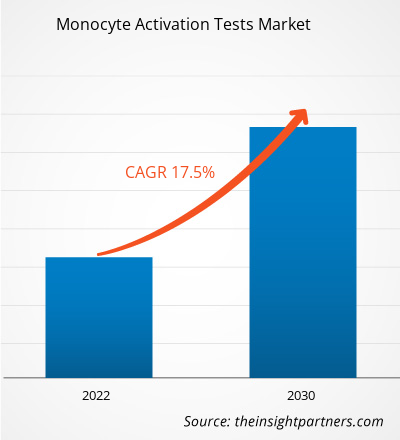[研究报告] 2022 年单核细胞活化测试市场规模价值 65,174.36 万美元,预计到 2030 年将达到 236,714.17 万美元;预计 2022 年至 2030 年的复合年增长率为 17.5%。
分析师观点
单核细胞活化测试市场分析包括对市场驱动因素的研究,例如患者对安全的担忧增加,以及制药、生物技术和医疗设备等终端用户行业对更安全的热原检测方法的需求激增。此外,预计单核细胞活化测试方法的技术发展将在预测期内推动单核细胞活化测试市场的增长。
根据来源,单核细胞活化测试市场分为 PMBC 和细胞系。PMBC 部分在 2022 年占有较大份额,预计在预测期内将继续保持类似的趋势。根据产品,单核细胞活化测试市场分为 MAT 试剂盒和试剂。MAT 试剂盒部分在 2022 年占有较大份额,预计在预测期内将继续保持类似的趋势。另一方面,预计试剂部分在预测期内将录得更高的复合年增长率。根据应用,单核细胞活化测试市场细分为药物开发、疫苗开发、医疗器械和其他(研究等)。药物开发部分在 2022 年占据最大份额,预计在 2022 年至 2030 年将出现同样的趋势。
单核细胞活化试验可检测内毒素和非内毒素热原协同作用导致的增强细胞因子释放。单核细胞活化试验 (MAT) 是一种体外检测方法,旨在检测肠外药物、生物制剂和医疗器械中所有类别的热原。在过去五年中,之前使用兔热原试验作为释放检测方法的疫苗已成为单核细胞活化试验 (MAT) 的最初采用者。此外,与 MAT 不同,细菌内毒素测试通常不适用于本质上具有热原性的产品或含有疫苗中常见的添加剂(如氢氧化铝)的产品,因为这些添加剂往往会干扰检测。在测试疫苗中采用 MAT 的几个例子包括脑膜炎奈瑟菌疫苗、高免疫血清、脑膜炎球菌疫苗、黄热病疫苗、宋内志贺氏菌疫苗、狂犬病疫苗、乙肝疫苗和蜱传脑炎病毒疫苗。
定制此报告以满足您的需求
您可以免费定制任何报告,包括本报告的部分内容、国家级分析、Excel 数据包,以及为初创企业和大学提供优惠和折扣
- 获取此报告的关键市场趋势。这个免费样品将包括数据分析,从市场趋势到估计和预测。
市场洞察
医疗器械行业需求不断增长
单核细胞活化试验 (MAT) 是一种基于人体细胞的试验,用于检测和量化细菌、真菌和病毒等热原。MAT 使用 ELISA 检测来测量处理过的血细胞释放的细胞因子。MAT 广泛可用,但很少用于代替基于动物的热原试验来评估医疗器械的生物相容性。美国国家毒理学计划替代毒理学方法评估跨部门中心 (NICEATM) 和 PETA 国际科学联盟有限公司 (PISC) 于 2018 年 9 月在美国国立卫生研究院召开了一次研讨会,以阐述在医疗器械测试中实施 MAT 使用的必要步骤。据 DXC Technology Company 旗下的 Luxoft 称,医疗器械通过预测算法和患者数据分析提供准确的诊断、有效的治疗和个性化护理,从而帮助医疗保健实现数字化转型。个性化医疗、植入式设备、智能医疗设备和非侵入性手术的技术进步正在通过提供更好的护理、改善患者治疗效果和降低成本来彻底改变整个医疗保健行业。医疗器械行业的增长反过来又推动了单核细胞活化测试方法的发展,预计在预测期内仍将保持类似的趋势。
市场机会
单核细胞活化测试方法的技术发展
单核细胞活化测试方法主要作为动物方法的替代方案引入,旨在提供在人体体外系统中进行热原检测的机会。单核细胞活化测试 (MAT) 在国际验证发布后于 2010 年被引入欧洲药典 (EP)。市场参与者对 MAT 检测和试剂的不断创新和发展,从根本上提高了可重复性、灵敏度和特异性,从而使其成为检测热原的可靠和更安全的选择。MAT 检测用于检测肠外产品(如药品和医疗器械)中的内毒素和非内毒素热原。通常,MAT 可根据监管指南提供传统动物测试的体外替代方案。兔热原测试和鲎变形细胞裂解物 (LAL) 测试广泛用于热原检测。这两种方法都使用动物,并显示出一些局限性。兔热原测试表明缺乏稳健性,因为动物反应可能与人类反应不同。此外,LAL 测试仅检测内毒素,忽略了测试样本中可能存在的非内毒素热原,从而导致安全风险。因此,为了克服这些限制,单核细胞活化测试 (MAT) 于 2010 年在欧洲药典中被采用,作为替代兔热原测试 (EP 第 2.6.30 章) 的药典方法,并在 FDA 行业指南中指定。市场参与者对 MAT 检测和试剂的不断创新和开发,从根本上提高了可重复性、灵敏度和特异性,从而使其成为检测热原的可靠且更安全的选择。
报告细分和范围
基于来源的洞察
根据来源,单核细胞活化测试市场分为 PMBC 和细胞系。PMBC 部分在 2022 年占有更大的份额,预计在预测期内将继续保持类似的趋势。预计同一部分在 2022 年至 2030 年期间的复合年增长率将更高。目前,全球有两种商业化的单核细胞活化测试细胞来源——Mono-Mac-6 (MM6) 细胞系和外周血单核细胞 (PBMC)。MM6 来源于单个急性单核细胞白血病患者的血液;因此,单核细胞有时没有反映稳定表达的 TLR,而稳定表达是持续检测致热污染物和启动健康人释放细胞因子所必需的。因此,使用这种细胞源的 MAT 结果的可重复性较低。欧洲药典(2.6.30) 还称基于 MM6 的 MAT 试剂盒在检测非内毒素热原方面的能力“有限”。另一方面,基于 PBMC 的 MAT 试剂盒从经过筛选的健康捐献者的混合血液中获取 PBMC,这意味着当与加标产品样本一起孵育时,单核细胞活化过程可帮助健康人体生长。因此,基于此细胞来源的 MAT 试剂盒的结果一直被发现具有可重复性。欧洲药典 (2.6.30) 认为此细胞来源在检测内毒素和非内毒素热原方面均表现优异。
目前市场上还有另外三家商业化的基于 PBMC 的单核细胞活化检测供应商。每家供应商的 LoD 分别为 0.125 EU/ml、0.02 EU/ml 和 0.016 EU/ml。CTL-MAT 检测的 LoD 为 0.004 EU/ml,是市场领先的检测之一,是全球最灵敏的单核细胞活化检测。
基于产品的洞察
根据产品,单核细胞活化测试市场分为 MAT 试剂盒和试剂。MAT 试剂盒部分在 2022 年占有较大份额,预计在预测期内将继续保持类似的趋势。另一方面,试剂部分预计在预测期内将实现更高的复合年增长率。
基于应用的洞察
根据应用,单核细胞活化测试市场细分为 药物开发、疫苗开发、医疗器械和其他(研究等)。药物开发部分在 2022 年占据最大份额,预计 2022 年至 2030 年将出现同样的趋势。根据美国国家医学图书馆的数据,药品是一组新兴的有机化合物,有助于改善患者的生活质量。制药行业参与品牌药和仿制药的生产、开发和营销。2014 年,全球医药总收入首次超过 1 万亿美元。自 2017 年以来,医药市场一直以每年 5.8% 的速度增长。同年,全球医药市场收入为 1,1430 亿美元,2021 年达到 1,4620 亿美元。单核细胞活化测试 (MAT) 旨在测试肠外药物、生物制剂和医疗器械中所有类别的热原。肠外给药的药品必须不含致热(发热)污染,因为这些物质可能会诱发患者先天免疫系统发生危及生命的全身反应。这是为了确保生物制品在给患者给药前不含污染性的致热物质。最初,RPT 和细菌内毒素检测 (BET)/鲎变形细胞裂解物测定 (LAL) 被用作离体试验选项。然而,对动物试验方法的严格规定迫使市场参与者开发一种替代方法,以尽量减少此类动物试验方法的使用。考虑到 RPT 和 BET 的局限性以及复杂产品制造的增加,欧洲药典引入了 MAT 活化测试方法,该方法模拟人道免疫反应并结合了 RPT(评估革兰氏阴性内毒素以外的致热原性)的优点和体外方法的优势。与 RPT 相比,MAT 可以作为一种完全定量的测试,无需使用动物,因此更适合用于检测本质上具有致热性且与生理相关的疫苗,因为它们使用的是人体细胞。MAT 测试方法能够检测血液衍生产品、细胞衍生产品、生物制剂和疫苗。MAT 测试方法还可以检测各种药品和医疗器械以及无法进行体内测试的产品(例如含有透明质酸的产品)。近年来,这些因素推动了整个单核细胞活化测试市场的发展,预计在预测期内也将呈现类似的趋势。
单核细胞活化测试市场区域洞察
Insight Partners 的分析师已详细解释了预测期内影响单核细胞活化测试市场的区域趋势和因素。本节还讨论了北美、欧洲、亚太地区、中东和非洲以及南美和中美洲的单核细胞活化测试市场细分和地理分布。

- 获取单核细胞活化测试市场的区域特定数据
单核细胞活化测试市场报告范围
| 报告属性 | 细节 |
|---|---|
| 2022 年市场规模 | 6517.436万美元 |
| 2030 年的市场规模 | 2.3671417亿美元 |
| 全球复合年增长率(2022 - 2030 年) | 17.5% |
| 史料 | 2020-2022 |
| 预测期 | 2022-2030 |
| 涵盖的领域 | 按来源
|
| 覆盖地区和国家 | 北美
|
| 市场领导者和主要公司简介 |
|
单核细胞活化测试市场参与者密度:了解其对业务动态的影响
单核细胞激活测试市场正在快速增长,这得益于终端用户需求的不断增长,而这些需求又源于消费者偏好的不断变化、技术进步以及对产品优势的认识不断提高等因素。随着需求的增加,企业正在扩大其产品范围,进行创新以满足消费者的需求,并利用新兴趋势,从而进一步推动市场增长。
市场参与者密度是指在特定市场或行业内运营的企业或公司的分布情况。它表明在给定市场空间中,相对于其规模或总市场价值,有多少竞争对手(市场参与者)存在。
在单核细胞活化测试市场运营的主要公司有:
- 德国达姆施塔特默克集团和/或其附属公司
- 查尔斯河国际实验室有限公司
- 赛默飞世尔科技
- 桑金
- 龙沙集团
免责声明:上面列出的公司没有按照任何特定顺序排列。

- 获取单核细胞激活测试市场顶级关键参与者概述
区域分析
根据地区,单核细胞活化测试市场分为北美、欧洲、亚太地区、南美和中美以及中东和非洲。北美在 2022 年占据了最大的市场份额,预计在预测期内将继续保持类似的趋势,其次是欧洲。美国药典 (USP) 和加拿大政府等组织对单核细胞活化测试的监管实践进一步推动了该地区单核细胞活化测试市场的整体增长。此外,对患者安全问题的日益关注和医疗效果的改善也是促进北美市场增长的因素之一。
德国达姆施塔特的默克集团和/或其附属公司、Charles River Laboratories International, Inc.、赛默飞世尔科技、Sanquin 和龙沙集团是单核细胞活化测试市场中的领先公司。
2023 年 10 月,Lonza 推出了两款新的快速单核细胞活化测试 (MAT) 系统,即 PyroCell MAT 快速系统和 PyroCell MAT 人血清 (HS) 快速系统,以简化和简化兔无热原测试。这些系统将取代 Lonza 传统的 MAT 系统试剂盒产品,新推出的产品包含新的 PeliKine 人 IL-6 快速 ELISA 试剂盒,可最大限度地减少动手时间并将结果获取时间从两天缩短到两小时。新测试为制药和生物技术制造商提供了更简单的 MAT 测试选项,以进行产品安全测试,同时有助于减少对动物的依赖。
- 历史分析(2 年)、基准年、预测(7 年)及复合年增长率
- PEST 和 SWOT 分析
- 市场规模价值/数量 - 全球、区域、国家
- 行业和竞争格局
- Excel 数据集


- Educational Furniture Market
- Employment Screening Services Market
- Excimer & Femtosecond Ophthalmic Lasers Market
- Medical Second Opinion Market
- Electronic Health Record Market
- Industrial Inkjet Printers Market
- Photo Printing Market
- Authentication and Brand Protection Market
- Sterilization Services Market
- Aesthetic Medical Devices Market

Report Coverage
Revenue forecast, Company Analysis, Industry landscape, Growth factors, and Trends

Segment Covered
This text is related
to segments covered.

Regional Scope
North America, Europe, Asia Pacific, Middle East & Africa, South & Central America

Country Scope
This text is related
to country scope.
常见问题
Merck KGaA, Darmstadt, Germany and/or its affiliates; Charles River Laboratories International, Inc.; Thermo Fisher Scientific; Sanquin; and Lonza Group are among the leading companies operating in the monocyte activation tests market.
Based on region, the monocyte activation tests market is segmented into North America, Europe, Asia Pacific, South & Central America, and the Middle East & Africa. North America captured the largest market share in 2022 and is expected to continue a similar trend during the forecast period, followed by Europe. Regulatory practices of monocyte activation tests by organizations such as United States Pharmacopeia (USP) and the Government of Canada have further fueled the overall growth of the monocyte activation tests market in the region. Also, increasing focus on patient safety concerns and improved healthcare outcomes is one of the factors aiding the market growth in North America.
Based on source, the monocyte activation tests market is bifurcated into PMBC and cell line. The PMBC segment held a larger share in 2022 and is expected to continue a similar trend during the forecast period. Based on products, the monocyte activation tests market is bifurcated into MAT kits and reagents. The MAT kits segment held a larger share in 2022 and is expected to continue a similar trend during the forecast period. On the other hand, the reagents segment is anticipated to record a higher CAGR during the forecasted period. Based on application, the monocyte activation tests market is segmented into drug development, vaccine development, medical devices, and others (research etc.). The drug development segment captured the largest share in 2022 and is expected to witness the same trend from 2022 to 2030.
The monocyte activation tests market analysis includes the study of market drivers such as a rise in safety concerns among patients and a surge in demand for safer pyrogen testing methods in end user industries such as pharmaceutical, biotech, and medical devices. Further, technological developments in monocyte activation test methods are anticipated to propel the monocyte activation tests market growth during the forecast period.
Trends and growth analysis reports related to Life Sciences : READ MORE..
The List of Companies - Monocyte Activation Tests Market
- Merck KGaA, Darmstadt, Germany and/or its affiliates
- Charles River Laboratories International, Inc.
- Thermo Fisher Scientific
- Sanquin
- Lonza Group
- MAT Biotech
- Cellmade Laboratories
- Labor LS SE & Co. KG
- BD Biosciences
- Beckman Coulter
The Insight Partners performs research in 4 major stages: Data Collection & Secondary Research, Primary Research, Data Analysis and Data Triangulation & Final Review.
- Data Collection and Secondary Research:
As a market research and consulting firm operating from a decade, we have published and advised several client across the globe. First step for any study will start with an assessment of currently available data and insights from existing reports. Further, historical and current market information is collected from Investor Presentations, Annual Reports, SEC Filings, etc., and other information related to company’s performance and market positioning are gathered from Paid Databases (Factiva, Hoovers, and Reuters) and various other publications available in public domain.
Several associations trade associates, technical forums, institutes, societies and organization are accessed to gain technical as well as market related insights through their publications such as research papers, blogs and press releases related to the studies are referred to get cues about the market. Further, white papers, journals, magazines, and other news articles published in last 3 years are scrutinized and analyzed to understand the current market trends.
- Primary Research:
The primarily interview analysis comprise of data obtained from industry participants interview and answers to survey questions gathered by in-house primary team.
For primary research, interviews are conducted with industry experts/CEOs/Marketing Managers/VPs/Subject Matter Experts from both demand and supply side to get a 360-degree view of the market. The primary team conducts several interviews based on the complexity of the markets to understand the various market trends and dynamics which makes research more credible and precise.
A typical research interview fulfils the following functions:
- Provides first-hand information on the market size, market trends, growth trends, competitive landscape, and outlook
- Validates and strengthens in-house secondary research findings
- Develops the analysis team’s expertise and market understanding
Primary research involves email interactions and telephone interviews for each market, category, segment, and sub-segment across geographies. The participants who typically take part in such a process include, but are not limited to:
- Industry participants: VPs, business development managers, market intelligence managers and national sales managers
- Outside experts: Valuation experts, research analysts and key opinion leaders specializing in the electronics and semiconductor industry.
Below is the breakup of our primary respondents by company, designation, and region:

Once we receive the confirmation from primary research sources or primary respondents, we finalize the base year market estimation and forecast the data as per the macroeconomic and microeconomic factors assessed during data collection.
- Data Analysis:
Once data is validated through both secondary as well as primary respondents, we finalize the market estimations by hypothesis formulation and factor analysis at regional and country level.
- Macro-Economic Factor Analysis:
We analyse macroeconomic indicators such the gross domestic product (GDP), increase in the demand for goods and services across industries, technological advancement, regional economic growth, governmental policies, the influence of COVID-19, PEST analysis, and other aspects. This analysis aids in setting benchmarks for various nations/regions and approximating market splits. Additionally, the general trend of the aforementioned components aid in determining the market's development possibilities.
- Country Level Data:
Various factors that are especially aligned to the country are taken into account to determine the market size for a certain area and country, including the presence of vendors, such as headquarters and offices, the country's GDP, demand patterns, and industry growth. To comprehend the market dynamics for the nation, a number of growth variables, inhibitors, application areas, and current market trends are researched. The aforementioned elements aid in determining the country's overall market's growth potential.
- Company Profile:
The “Table of Contents” is formulated by listing and analyzing more than 25 - 30 companies operating in the market ecosystem across geographies. However, we profile only 10 companies as a standard practice in our syndicate reports. These 10 companies comprise leading, emerging, and regional players. Nonetheless, our analysis is not restricted to the 10 listed companies, we also analyze other companies present in the market to develop a holistic view and understand the prevailing trends. The “Company Profiles” section in the report covers key facts, business description, products & services, financial information, SWOT analysis, and key developments. The financial information presented is extracted from the annual reports and official documents of the publicly listed companies. Upon collecting the information for the sections of respective companies, we verify them via various primary sources and then compile the data in respective company profiles. The company level information helps us in deriving the base number as well as in forecasting the market size.
- Developing Base Number:
Aggregation of sales statistics (2020-2022) and macro-economic factor, and other secondary and primary research insights are utilized to arrive at base number and related market shares for 2022. The data gaps are identified in this step and relevant market data is analyzed, collected from paid primary interviews or databases. On finalizing the base year market size, forecasts are developed on the basis of macro-economic, industry and market growth factors and company level analysis.
- Data Triangulation and Final Review:
The market findings and base year market size calculations are validated from supply as well as demand side. Demand side validations are based on macro-economic factor analysis and benchmarks for respective regions and countries. In case of supply side validations, revenues of major companies are estimated (in case not available) based on industry benchmark, approximate number of employees, product portfolio, and primary interviews revenues are gathered. Further revenue from target product/service segment is assessed to avoid overshooting of market statistics. In case of heavy deviations between supply and demand side values, all thes steps are repeated to achieve synchronization.
We follow an iterative model, wherein we share our research findings with Subject Matter Experts (SME’s) and Key Opinion Leaders (KOLs) until consensus view of the market is not formulated – this model negates any drastic deviation in the opinions of experts. Only validated and universally acceptable research findings are quoted in our reports.
We have important check points that we use to validate our research findings – which we call – data triangulation, where we validate the information, we generate from secondary sources with primary interviews and then we re-validate with our internal data bases and Subject matter experts. This comprehensive model enables us to deliver high quality, reliable data in shortest possible time.


 获取此报告的免费样本
获取此报告的免费样本